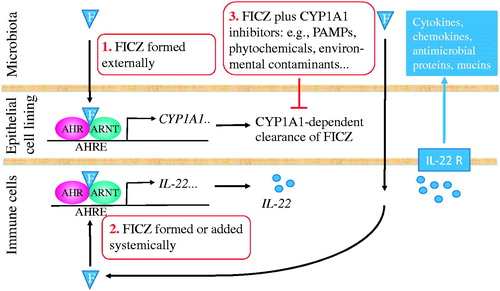Figures & data
Table 1. Effects by FICZ on disease severity in murine models of human diseases.
![Figure 1. Formation pathways of 6-formylindolo[3,2-b]carbazole (FICZ) and indolo[3,2-b]carbazole-6-carboxylic acid (CICZ) from tryptophan directly or from the tryptophan metabolites tryptamine and indolo-3-pyruvic acid, respectively, via the common precursor indolo-3-acetaldehyde. All three pathways produce the same precursor of FICZ.](/cms/asset/0c584692-7861-4bb7-bc19-a485dd8da253/itxc_a_1493086_f0001_c.jpg)
![Figure 2. The FICZ/AHR/CYP1A1 feedback loop can be blocked by various types of inhibitors. Abbreviations: AHR, aryl hydrocarbon receptor; AHRE, AHR response element; ARNT, AHR nuclear translocator; CYP1A1, cytochrome P4501A1; FICZ, 6-formylindolo[3,2-b]carbazole; kcat/Km, catalytic efficiency; Kd, dissociation constant; PAMPs, pathogen associated molecular patterns; ROS, reactive oxygen species.](/cms/asset/a45fae7e-5d82-4ae8-bc56-a060601698e1/itxc_a_1493086_f0002_c.jpg)

